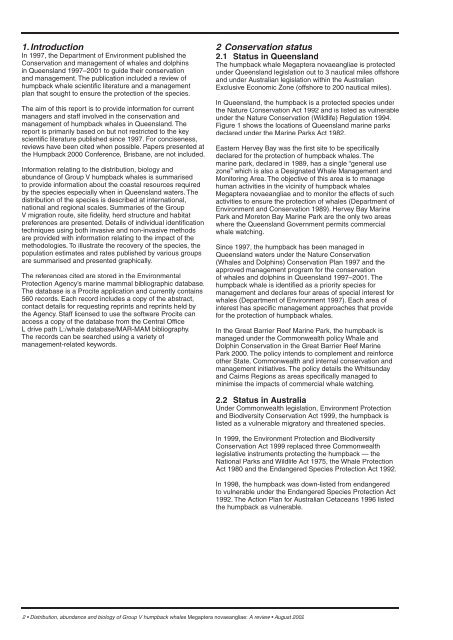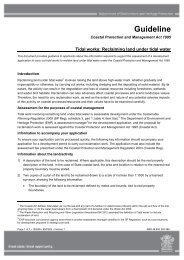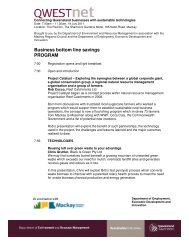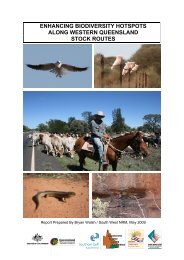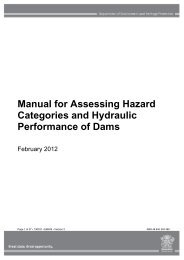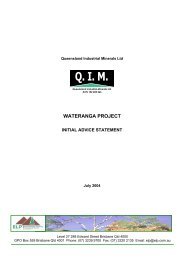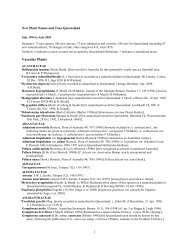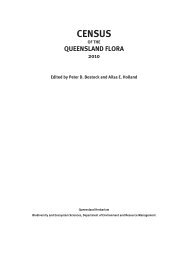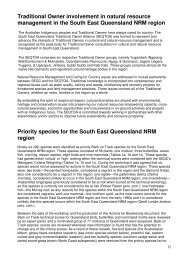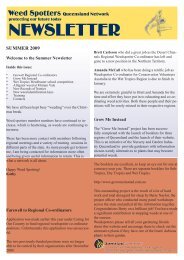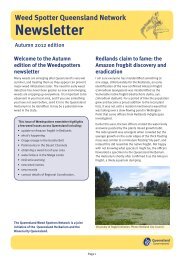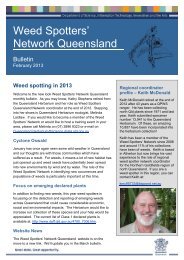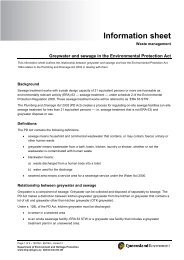Distribution, abundance and biology of Group V humpback whales ...
Distribution, abundance and biology of Group V humpback whales ...
Distribution, abundance and biology of Group V humpback whales ...
Create successful ePaper yourself
Turn your PDF publications into a flip-book with our unique Google optimized e-Paper software.
1.Introduction<br />
In 1997, the Department <strong>of</strong> Environment published the<br />
Conservation <strong>and</strong> management <strong>of</strong> <strong>whales</strong> <strong>and</strong> dolphins<br />
in Queensl<strong>and</strong> 1997–2001 to guide their conservation<br />
<strong>and</strong> management. The publication included a review <strong>of</strong><br />
<strong>humpback</strong> whale scientifi c literature <strong>and</strong> a management<br />
plan that sought to ensure the protection <strong>of</strong> the species.<br />
The aim <strong>of</strong> this report is to provide information for current<br />
managers <strong>and</strong> staff involved in the conservation <strong>and</strong><br />
management <strong>of</strong> <strong>humpback</strong> <strong>whales</strong> in Queensl<strong>and</strong>. The<br />
report is primarily based on but not restricted to the key<br />
scientifi c literature published since 1997. For conciseness,<br />
reviews have been cited when possible. Papers presented at<br />
the Humpback 2000 Conference, Brisbane, are not included.<br />
Information relating to the distribution, <strong>biology</strong> <strong>and</strong><br />
<strong>abundance</strong> <strong>of</strong> <strong>Group</strong> V <strong>humpback</strong> <strong>whales</strong> is summarised<br />
to provide information about the coastal resources required<br />
by the species especially when in Queensl<strong>and</strong> waters. The<br />
distribution <strong>of</strong> the species is described at international,<br />
national <strong>and</strong> regional scales. Summaries <strong>of</strong> the <strong>Group</strong><br />
V migration route, site fi delity, herd structure <strong>and</strong> habitat<br />
preferences are presented. Details <strong>of</strong> individual identifi cation<br />
techniques using both invasive <strong>and</strong> non-invasive methods<br />
are provided with information relating to the impact <strong>of</strong> the<br />
methodologies. To illustrate the recovery <strong>of</strong> the species, the<br />
population estimates <strong>and</strong> rates published by various groups<br />
are summarised <strong>and</strong> presented graphically.<br />
The references cited are stored in the Environmental<br />
Protection Agency’s marine mammal bibliographic database.<br />
The database is a Procite application <strong>and</strong> currently contains<br />
560 records. Each record includes a copy <strong>of</strong> the abstract,<br />
contact details for requesting reprints <strong>and</strong> reprints held by<br />
the Agency. Staff licensed to use the s<strong>of</strong>tware Procite can<br />
access a copy <strong>of</strong> the database from the Central Offi ce<br />
L drive path L:/whale database/MAR-MAM bibliography.<br />
The records can be searched using a variety <strong>of</strong><br />
management-related keywords.<br />
2 • <strong>Distribution</strong>, <strong>abundance</strong> <strong>and</strong> <strong>biology</strong> <strong>of</strong> <strong>Group</strong> V <strong>humpback</strong> <strong>whales</strong> Megaptera novaeangliae: A review • August 2002<br />
2 Conservation status<br />
2.1 Status in Queensl<strong>and</strong><br />
The <strong>humpback</strong> whale Megaptera novaeangliae is protected<br />
under Queensl<strong>and</strong> legislation out to 3 nautical miles <strong>of</strong>fshore<br />
<strong>and</strong> under Australian legislation within the Australian<br />
Exclusive Economic Zone (<strong>of</strong>fshore to 200 nautical miles).<br />
In Queensl<strong>and</strong>, the <strong>humpback</strong> is a protected species under<br />
the Nature Conservation Act 1992 <strong>and</strong> is listed as vulnerable<br />
under the Nature Conservation (Wildlife) Regulation 1994.<br />
Figure 1 shows the locations <strong>of</strong> Queensl<strong>and</strong> marine parks<br />
declared under the Marine Parks Act 1982.<br />
Eastern Hervey Bay was the fi rst site to be specifi cally<br />
declared for the protection <strong>of</strong> <strong>humpback</strong> <strong>whales</strong>. The<br />
marine park, declared in 1989, has a single “general use<br />
zone” which is also a Designated Whale Management <strong>and</strong><br />
Monitoring Area. The objective <strong>of</strong> this area is to manage<br />
human activities in the vicinity <strong>of</strong> <strong>humpback</strong> <strong>whales</strong><br />
Megaptera novaeangliae <strong>and</strong> to monitor the effects <strong>of</strong> such<br />
activities to ensure the protection <strong>of</strong> <strong>whales</strong> (Department <strong>of</strong><br />
Environment <strong>and</strong> Conservation 1989). Hervey Bay Marine<br />
Park <strong>and</strong> Moreton Bay Marine Park are the only two areas<br />
where the Queensl<strong>and</strong> Government permits commercial<br />
whale watching.<br />
Since 1997, the <strong>humpback</strong> has been managed in<br />
Queensl<strong>and</strong> waters under the Nature Conservation<br />
(Whales <strong>and</strong> Dolphins) Conservation Plan 1997 <strong>and</strong> the<br />
approved management program for the conservation<br />
<strong>of</strong> <strong>whales</strong> <strong>and</strong> dolphins in Queensl<strong>and</strong> 1997–2001. The<br />
<strong>humpback</strong> whale is identifi ed as a priority species for<br />
management <strong>and</strong> declares four areas <strong>of</strong> special interest for<br />
<strong>whales</strong> (Department <strong>of</strong> Environment 1997). Each area <strong>of</strong><br />
interest has specifi c management approaches that provide<br />
for the protection <strong>of</strong> <strong>humpback</strong> <strong>whales</strong>.<br />
In the Great Barrier Reef Marine Park, the <strong>humpback</strong> is<br />
managed under the Commonwealth policy Whale <strong>and</strong><br />
Dolphin Conservation in the Great Barrier Reef Marine<br />
Park 2000. The policy intends to complement <strong>and</strong> reinforce<br />
other State, Commonwealth <strong>and</strong> internal conservation <strong>and</strong><br />
management initiatives. The policy details the Whitsunday<br />
<strong>and</strong> Cairns Regions as areas specifi cally managed to<br />
minimise the impacts <strong>of</strong> commercial whale watching.<br />
2.2 Status in Australia<br />
Under Commonwealth legislation, Environment Protection<br />
<strong>and</strong> Biodiversity Conservation Act 1999, the <strong>humpback</strong> is<br />
listed as a vulnerable migratory <strong>and</strong> threatened species.<br />
In 1999, the Environment Protection <strong>and</strong> Biodiversity<br />
Conservation Act 1999 replaced three Commonwealth<br />
legislative instruments protecting the <strong>humpback</strong> — the<br />
National Parks <strong>and</strong> Wildlife Act 1975, the Whale Protection<br />
Act 1980 <strong>and</strong> the Endangered Species Protection Act 1992.<br />
In 1998, the <strong>humpback</strong> was down-listed from endangered<br />
to vulnerable under the Endangered Species Protection Act<br />
1992. The Action Plan for Australian Cetaceans 1996 listed<br />
the <strong>humpback</strong> as vulnerable.


